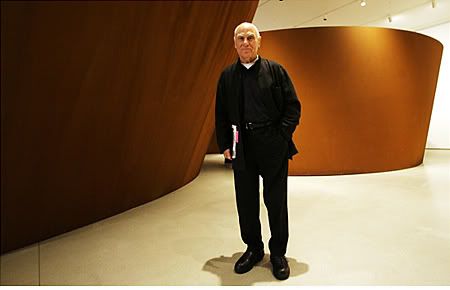
He emerged out of a radical art scene in the 1960s and went on to become one of America's most controversial artists - provoking some New Yorkers to threaten him with death. Now 70 and hailed as the world's 'greatest living sculptor', he remains a combative figure in the art world.
Richard Serra
Fileds: Minimalist sculptor
Works: Intersection II (1992) and Torqued Ellipse IV (1999)
Where to see: The Matter of Time-Guggenheim Museum Bilbao (Permanent exhibit)
Born in 1939, Richard Serra is one of the most significant artists of his generation. His groundbreaking sculpture explores the exchange between artwork, site, and viewer. He has produced unparalleled large-scale, site-specific sculptures for architectural, urban and landscape settings.
Fileds: Minimalist sculptor
Works: Intersection II (1992) and Torqued Ellipse IV (1999)
Where to see: The Matter of Time-Guggenheim Museum Bilbao (Permanent exhibit)
Born in 1939, Richard Serra is one of the most significant artists of his generation. His groundbreaking sculpture explores the exchange between artwork, site, and viewer. He has produced unparalleled large-scale, site-specific sculptures for architectural, urban and landscape settings.


Richard Serra’s work since the 1960s has focused on the industrial materials that he had worked with as a youth in West Coast steel mills and shipyards: steel and lead. Serra’s work is known for it’s immense physicality, compounded by the breathtaking bends and curves of steel plates that carve private moment out of public spaces. Many of these pieces are self-supporting and emphasize the weight and nature of the materials. Rolls of lead are designed to sag over time. His exterior steel sculptures go through an initial oxidation process, but after 8-10 years, the patina of the steel settles to one color that will remain relatively stable over the piece's life.


Serra’s sculptures don’t require any prior knowledge of the artist’s work, or of any artist’s work; the experience itself, a sort of industrial sublime, is accessible and even generous. Standing under a sheet of steel that bulges above your head like a tidal wave, you feel the smallness and the frailty of your own body in a way that thrusts you back to childhood experiences of cliff edges, rollercoasters, and thunderstorms. It’s a primal experience that lights up the dark parts of your memory.

The Matter of Time, Sierra's best-known work, also the largest sculpture commission in history, is the only permanent exhibit at Guggenheim Museum Bilbao. The whole work consists of eight sculptures measuring between 12 and 14 feet in height and weighing from 44 to 276 tons.



The Matter of Time allows the viewer to perceive the evolution of the artist’s sculptural forms, from the relative simplicity of a double ellipse to the complexity of a spiral. The last two pieces of this sculpture are created from sections of toruses and spheres that produce different effects on the movement and perception of the viewer. These are unexpectedly transformed as the visitor walks through and around them, creating an unforgettable, dizzying feeling of space in motion. The entire room is part of the sculptural field. As he has done in other sculptures composed of many pieces, the artist has arranged the works deliberately in order to move the viewer through them and through the space surrounding them. The layout of the works along the gallery creates corridors with different, always unexpected proportions (wide, narrow, long, compressed, high, low). The installation also includes a progression in time. On the one hand, there is the chronological time that it takes to walk through and observe it from beginning to end. On the other, there is the time during which the viewer experiences the fragments of visual and physical memory, which are combined and re-experienced.
What Serra 's sculptures give you is about physical experience; and not just about looking.



via art:21 | www.guggenheim-bilbao.es


Serra’s sculptures don’t require any prior knowledge of the artist’s work, or of any artist’s work; the experience itself, a sort of industrial sublime, is accessible and even generous. Standing under a sheet of steel that bulges above your head like a tidal wave, you feel the smallness and the frailty of your own body in a way that thrusts you back to childhood experiences of cliff edges, rollercoasters, and thunderstorms. It’s a primal experience that lights up the dark parts of your memory.

The Matter of Time, Sierra's best-known work, also the largest sculpture commission in history, is the only permanent exhibit at Guggenheim Museum Bilbao. The whole work consists of eight sculptures measuring between 12 and 14 feet in height and weighing from 44 to 276 tons.



The Matter of Time allows the viewer to perceive the evolution of the artist’s sculptural forms, from the relative simplicity of a double ellipse to the complexity of a spiral. The last two pieces of this sculpture are created from sections of toruses and spheres that produce different effects on the movement and perception of the viewer. These are unexpectedly transformed as the visitor walks through and around them, creating an unforgettable, dizzying feeling of space in motion. The entire room is part of the sculptural field. As he has done in other sculptures composed of many pieces, the artist has arranged the works deliberately in order to move the viewer through them and through the space surrounding them. The layout of the works along the gallery creates corridors with different, always unexpected proportions (wide, narrow, long, compressed, high, low). The installation also includes a progression in time. On the one hand, there is the chronological time that it takes to walk through and observe it from beginning to end. On the other, there is the time during which the viewer experiences the fragments of visual and physical memory, which are combined and re-experienced.
What Serra 's sculptures give you is about physical experience; and not just about looking.



via art:21 | www.guggenheim-bilbao.es
No comments:
Post a Comment